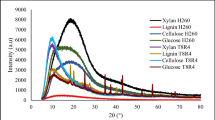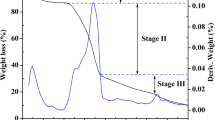Abstract
Volatile organic compounds have posed a serious threat to the environment and human health, which require urgent and effective removal. In recent years, the preparation of porous carbon from biomass waste for volatile organic compounds adsorption has attracted increasing attention as a very cost-effective and promising technology. In this study, porous carbon was synthesized from orange peel by urea-assisted hydrothermal carbonization and KOH activation. The role of typical components (cellulose, hemicellulose, and lignin) in pore development and volatile organic compounds adsorption was investigated. Among the three components, hemicellulose was the major contributor to high porosity and abundant micropores in porous carbon. Higher hemicellulose content led to more abundant −COOR, amine-N, and pyrrolic/pyridonic-N in the derived hydrochar, which were favorable for porosity formation during activation. In this case, the toluene adsorption capacity of the porous carbon improved from 382.8 to 485.3 mg·g−1. Unlike hemicellulose, cellulose reduced the >C=O, amine-N, and pyrrolic/pyridonic-N content of the hydrochar, which caused porosity deterioration and worse toluene adsorption performance. Lignin bestowed the hydrochar with slightly increased −COOR, pyrrolic/pyridonic-N, and graphitic-N, and reduced >C=O, resulting in comparatively poor porosity and more abundant micropores. In general, the obtained porous carbon possessed abundant micropores and high specific surface area, with the highest up to 2882 m2·g−1. This study can provide guidance for selecting suitable biomass waste to synthesize porous carbon with better porosity for efficient volatile organic compounds adsorption.

Similar content being viewed by others
References
Gałęzowska G, Chraniuk M, Wolska L. In vitro assays as a tool for determination of VOCs toxic effect on respiratory system: a critical review. Trends in Analytical Chemistry, 2016, 77: 14–22
Zheng C, Shen J, Zhang Y, Huang W, Zhu X, Wu X, Chen L, Gao X, Cen K. Quantitative assessment of industrial VOC emissions in China: historical trend, spatial distribution, uncertainties, and projection. Atmospheric Environment, 2017, 150: 116–125
Colman Lerner J E, Sanchez E Y, Sambeth J E, Porta A A. Characterization and health risk assessment of VOCs in occupational environments in Buenos Aires, Argentina. Atmospheric Environment, 2012, 55: 440–447
Zhang Z, Jiang Z, Shangguan W. Low-temperature catalysis for VOCs removal in technology and application: a state-of-the-art review. Catalysis Today, 2016, 264: 270–278
Yang C, Miao G, Pi Y, Xia Q, Wu J, Li Z, Xiao J. Abatement of various types of VOCs by adsorption/catalytic oxidation: a review. Chemical Engineering Journal, 2019, 370: 1128–1153
Li X, Zhang L, Yang Z, Wang P, Yan Y, Ran J. Adsorption materials for volatile organic compounds (VOCs) and the key factors for VOCs adsorption process: a review. Separation and Purification Technology, 2020, 235: 116213
Twumasi E, Forslund M, Norberg P, Sjöström C. Carbon-silica composites prepared by the precipitation method. Effect of the synthesis parameters on textural characteristics and toluene dynamic adsorption. Journal of Porous Materials, 2012, 19(3): 333–343
Son H K, Sivakumar S, Rood M J, Kim B J. Electrothermal adsorption and desorption of volatile organic compounds on activated carbon fiber cloth. Journal of Hazardous Materials, 2016, 301: 27–34
Jothi Ramalingam R, Sivachidambaram M, Vijaya J J, Al-Lohedan H A, Muthumareeswaran M R. Synthesis of porous activated carbon powder formation from fruit peel and cow dung waste for modified electrode fabrication and application. Biomass and Bioenergy, 2020, 142: 105800
Jain A, Balasubramanian R, Srinivasan M P. Tuning hydrochar properties for enhanced mesopore development in activated carbon by hydrothermal carbonization. Microporous and Mesoporous Materials, 2015, 203: 178–185
Singh G, Lakhi K S, Sil S, Bhosale S V, Kim I, Albahily K, Vinu A. Biomass derived porous carbon for CO2 capture. Carbon, 2019, 148: 164–186
Yin J, Zhang W, Alhebshi N A, Salah N, Alshareef H N. Synthesis strategies of porous carbon for supercapacitor applications. Small Methods, 2020, 4(3): 1900853
Song M, Zhou Y, Ren X, Wan J, Du Y, Wu G, Ma F. Biowaste-based porous carbon for supercapacitor: the influence of preparation processes on structure and performance. Journal of Colloid and Interface Science, 2019, 535: 276–286
Zhao P, Shen Y, Ge S, Chen Z, Yoshikawa K. Clean solid biofuel production from high moisture content waste biomass employing hydrothermal treatment. Applied Energy, 2014, 131: 345–367
Shen Y, Zhang N. A facile synthesis of nitrogen-doped porous carbons from lignocellulose and protein wastes for VOCs sorption. Environmental Research, 2020, 189: 109956
Zhang X, Gao B, Fang J, Zou W, Dong L, Cao C, Zhang J, Li Y, Wang H. Chemically activated hydrochar as an effective adsorbent for volatile organic compounds (VOCs). Chemosphere, 2019, 218: 680–686
Başakçılardan Kabakcı S, Baran S S. Hydrothermal carbonization of various lignocellulosics: fuel characteristics of hydrochars and surface characteristics of activated hydrochars. Waste Management, 2019, 100: 259–268
Falco C, Baccile N, Titirici M. Morphological and structural differences between glucose, cellulose and lignocellulosic biomass derived hydrothermal carbons. Green Chemistry, 2011, 13(11): 3273
Jain A, Balasubramanian R, Srinivasan M P. Hydrothermal conversion of biomass waste to activated carbon with high porosity: a review. Chemical Engineering Journal, 2016, 283: 789–805
Basso D, Patuzzi F, Castello D, Baratieri M, Rada E C, Weiss-Hortala E, Fiori L. Agro-industrial waste to solid biofuel through hydrothermal carbonization. Waste Management, 2016, 47: 114–121
Libra J A, Ro K S, Kammann C, Funke A, Berge N D, Neubauer Y, Titirici M, Fühner C, Bens O, Kern J, Emmerich K-H. Hydrothermal carbonization of biomass residuals: a comparative review of the chemistry, processes and applications of wet and dry pyrolysis. Biofuels, 2011, 2(1): 71–106
Ogihara Y, Smith R L, Inomata H, Arai K. Direct observation of cellulose dissolution in subcritical and supercritical water over a wide range of water densities (550–1000 kg·m−3). Cellulose, 2005, 12(6): 595–606
Sevilla M, Fuertes A B. The production of carbon materials by hydrothermal carbonization of cellulose. Carbon, 2009, 47(9): 2281–2289
Kang S, Li X, Fan J, Chang J. Characterization of hydrochars produced by hydrothermal carbonization of lignin, cellulose, D-xylose, and wood meal. Industrial & Engineering Chemistry Research, 2012, 51(26): 9023–9031
Fang Z, Sato T, Smith R L, Inomata H, Arai K, Kozinski J A. Reaction chemistry and phase behavior of lignin in high-temperature and supercritical water. Bioresource Technology, 2008, 99(9): 3424–3430
Dinjus E, Kruse A, Tröger N. Hydrothermal carbonization: 1. Influence of lignin in lignocelluloses. Chemical Engineering & Technology, 2011, 83(10): 1734–1741
Xiao K, Liu H, Li Y, Yi L, Zhang X, Hu H, Yao H. Correlations between hydrochar properties and chemical constitution of orange peel waste during hydrothermal carbonization. Bioresource Technology, 2018, 265: 432–436
Jain A, Balasubramanian R, Srinivasan M P. Production of high surface area mesoporous activated carbons from waste biomass using hydrogen peroxide-mediated hydrothermal treatment for adsorption applications. Chemical Engineering Journal, 2015, 273: 622–629
Islam M A, Ahmed M J, Khanday W A, Asif M, Hameed B H. Mesoporous activated coconut shell-derived hydrochar prepared via hydrothermal carbonization-NaOH activation for methylene blue adsorption. Journal of Environmental Management, 2017, 203: 237–244
Zhu M, Zhou K, Sun X, Zhao Z, Tong Z, Zhao Z. Hydrophobic N-doped porous biocarbon from dopamine for high selective adsorption of p-xylene under humid conditions. Chemical Engineering Journal, 2017, 317: 660–672
Yang F, Li W, Zhang L, Tu W, Wang X, Li L, Yu C, Gao Q, Yuan A, Pan J. Drastically boosting volatile acetone capture enabled by N-doping activated carbon: an interesting deep surface digging effect. Separation and Purification Technology, 2021, 276: 119280
Xiao K, Liu H, Li Y, Yang G, Wang Y, Yao H. Excellent performance of porous carbon from urea-assisted hydrochar of orange peel for toluene and iodine adsorption. Chemical Engineering Journal, 2020, 382: 122997
Romero-Anaya A J, Lillo-Ródenas M A, Linares-Solano A. Activation of a spherical carbon for toluene adsorption at low concentration. Carbon, 2014, 77: 616–626
Zhang X, Gao B, Creamer A E, Cao C, Li Y. Adsorption of VOCs onto engineered carbon materials: a review. Journal of Hazardous Materials, 2017, 338: 102–123
Chen G, Yu H, Lin F, Zhang Z, Yan B, Song Y. Utilization of edible fungi residues towards synthesis of high-performance porous carbon for effective sorption of Cl-VOCs. Science of the Total Environment, 2020, 727: 138475
Yang Y, Lin B, Sun C, Tang M, Lu S, Huang Q, Yan J. Facile synthesis of tailored mesopore-enriched hierarchical porous carbon from food waste for rapid removal of aromatic VOCs. Science of the Total Environment, 2021, 773: 145453
Lillo-Ródenas M A, Cazorla-Amorós D, Linares-Solano A. Behaviour of activated carbons with different pore size distributions and surface oxygen groups for benzene and toluene adsorption at low concentrations. Carbon, 2005, 43(8): 1758–1767
Vasquez-Elizondo L J, Rendón-Ángeles J C, Matamoros-Veloza Z, López-Cuevas J, Yanagisawa K. Urea decomposition enhancing the hydrothermal synthesis of lithium iron phosphate powders: effect of the lithium precursor. Advanced Powder Technology, 2017, 28(6): 1593–1602
Chen C, Boldor D, Aita G, Walker M. Ethanol production from sorghum by a microwave-assisted dilute ammonia pretreatment. Bioresource Technology, 2012, 110: 190–197
Wang T, Zhai Y, Zhu Y, Li C, Zeng G. A review of the hydrothermal carbonization of biomass waste for hydrochar formation: process conditions, fundamentals, and physicochemical properties. Renewable & Sustainable Energy Reviews, 2018, 90: 223–247
Si W, Zhou J, Zhang S, Li S, Xing W, Zhuo S. Tunable N-doped or dual N, S-doped activated hydrothermal carbons derived from human hair and glucose for supercapacitor applications. Electrochimica Acta, 2013, 107: 397–405
Chen N, Huang Y, Hou X, Ai Z, Zhang L. Photochemistry of hydrochar: reactive oxygen species generation and sulfadimidine degradation. Environmental Science & Technology, 2017, 51(19): 11278–11287
Wang D, Su D. Heterogeneous nanocarbon materials for oxygen reduction reaction. Energy & Environmental Science, 2014, 7(2): 576–591
Rao L, Ma R, Liu S, Wang L, Wu Z, Yang J, Hu X. Nitrogen enriched porous carbons from d-glucose with excellent CO2 capture performance. Chemical Engineering Journal, 2019, 362: 794–801
Li Y, Zou B, Hu C, Cao M. Nitrogen-doped porous carbon nanofiber webs for efficient CO2 capture and conversion. Carbon, 2016, 99: 79–89
Wu Q, Li W, Liu S, Jin C. Hydrothermal synthesis of N-doped spherical carbon from carboxymethylcellulose for CO2 capture. Applied Surface Science, 2016, 369: 101–107
Seredych M, Hulicova-Jurcakova D, Lu G Q, Bandosz T J. Surface functional groups of carbons and the effects of their chemical character, density and accessibility to ions on electrochemical performance. Carbon, 2008, 46(11): 1475–1488
Latham K G, Simone M I, Dose W M, Allen J A, Donne S W. Synchrotron based NEXAFS study on nitrogen doped hydrothermal carbon: insights into surface functionalities and formation mechanisms. Carbon, 2017, 114: 566–578
Baccile N, Laurent G, Coelho C, Babonneau F, Zhao L, Titirici M. Structural insights on nitrogen-containing hydrothermal carbon using solid-state magic angle spinning 13C and 15N nuclear magnetic resonance. Journal of Physical Chemistry C, 2011, 115(18): 8976–8982
Billaud C, Maraschin C, Chow Y, Chériot S, Peyrat-Maillard M, Nicolas J. Maillard reaction products as “natural antibrowning” agents in fruit and vegetable technology. Molecular Nutrition & Food Research, 2005, 49(7): 656–662
Dominguez J M, Cao N, Gong C S, Tsao G T. Dilute acid hemicellulose hydrolysates from corn cobs for xylitol production by yeast. Bioresource Technology, 1997, 61(1): 85–90
Kirk T K, Obst J R. Lignin determination. Methods in Enzymology, 1988, 161: 87–101
Thygesen A, Oddershede J, Lilholt H, Thomsen A B, Ståhl K. On the determination of crystallinity and cellulose content in plant fibres. Cellulose, 2005, 12(6): 563–576
Acknowledgements
This work was supported by the Shenzhen Science and Technology Program (Grant No. JSGG20210802154804013). The authors also thank the Analytical and Testing Center of Huazhong University of Science and Technology for testing of the samples.
Author information
Authors and Affiliations
Corresponding author
Rights and permissions
About this article
Cite this article
Zhou, Q., Liu, H., Wang, Y. et al. Synthesis of porous carbon from orange peel waste for effective volatile organic compounds adsorption: role of typical components. Front. Chem. Sci. Eng. 17, 942–953 (2023). https://doi.org/10.1007/s11705-022-2264-x
Received:
Accepted:
Published:
Issue Date:
DOI: https://doi.org/10.1007/s11705-022-2264-x




